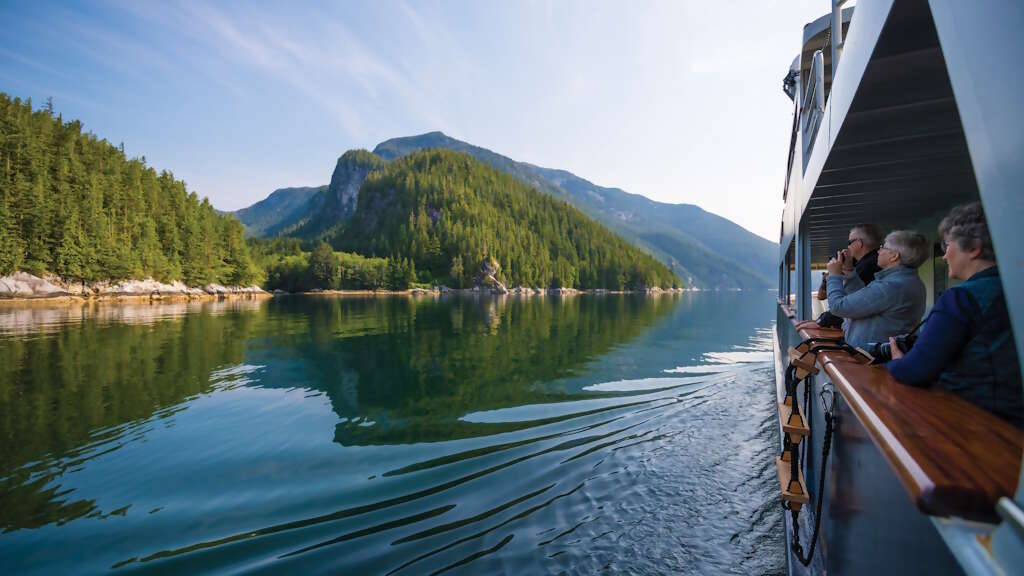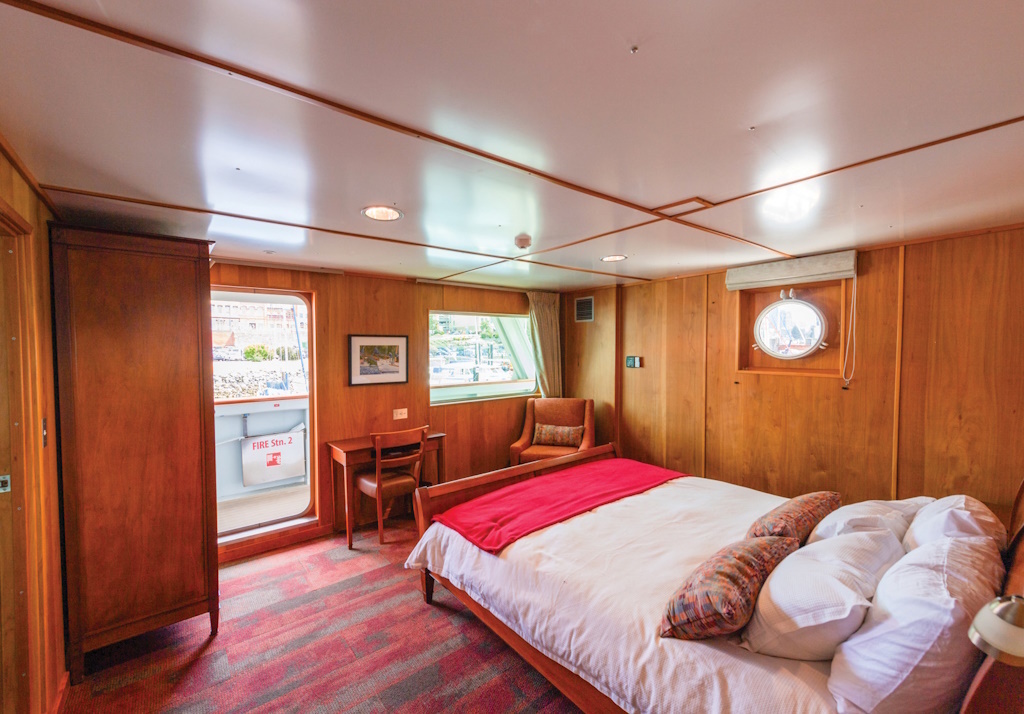
Canadian company Maple Leaf Adventures sails into the isolated beauty of British Columbia

Cascardia
IN THE REMOTE PEACE of British Columbia's Great Bear Rainforest, I heard the exhalations of humpback whales, the howls of elusive marine wolves and the thunderous rush of a gushing glacial waterfall as I held my cup to capture a drink.

Humpback whale
Canadian eco-tourism company Maple Leaf Adventures' 138-foot expedition catamaran Cascadia makes this remarkable area of rainforests and mountain-lined ¡ords accessible to travellers. There are no through roads in this area roughly the size of the Republic of Ireland and small vessels like Cascadia are the only way into the heart of the Great Bear Rainforest.

Spirit bear
The Victoria B.C.-based company has been bringing curious travellers here, as well as to Haida Gwaii, northwest Vancouver Island and Alaska, since 1987.Cascadia is the largest and newest of the three vessels in the small-ship fleet.
Built in New Zealand, Cascadia can accommodate 24 guests. It's a hand-crafted, 12-cabin beauty, with large windows and gleaming wood trim and interiors decorated with First Nations' art. Most cabins have doors leading onto the deck. The fuel-saving engines and twin hulls make for a quiet, smooth ride.

Cascadia accommodation
With 18 guests from Canada, the U.S., Germany and the U.K. on board, we headed into the Kitlope, the last stand of protected and unbroken temperate rainforest on the planet and home to First Nations people since time immemorial.
Maple Leaf president and co-owner Kevin Smith was expedition leader. As we nosed into the Douglas Channel from a small marina near Kitamaat village, he said we were about to be immersed in "a unique very, very special corner of this one blue planet."

Kevin Smith
Typical of expedition sailing, what we saw and where we went was dictated by tides, weather and the whims of the wildlife. The daily itinerary posted in the salon before breakfast was jokingly called "Plan A." We learned to relax and let the day come to us.
There were morning and afternoon tender explorations aboard the pair of 10-passenger vessels Auklet and Puffin. Thanks to their drop fronts, it was easy to get off and on the tenders at island beaches and for rainforest hikes.
What we didn't see hardly mattered given the natural wonders we did encounter. On an early morning tender excursion, we watched a group of sea wolves reunite with spine-tingling howls on a white-sand beach. This rare marine species lives primarily on seafood. Unlike other wolves, it swims to hunt. We were thrilled to watch one paddle for shore from a rocky islet.

Sea wolf
The cabins were comfortable. Heated bathroom floors were welcome on chilly mornings. But I didn't spend a lot of time in my room. If I wasn't admiring the scenery, watching for humpback whales, or relaxing in the top-deck hot tub, I was in the roomy salon. The combination lounge, dining room and hangout hub is the heart of Cascadia. It's ringed with windows, has comfy furniture and two long tables for meals.

We gathered here to play cards or peruse the small library of photography, nature and local history books. Some sat at the long dining table to work on a wildlife and nature-mapping project with on-board naturalist Janet Winbourne. Others tried watercolours or indulged in a sofa catnap.

Casdadia lounge/ dining room
On our eight-day sailing, we enjoyed excellent locally sourced food prepared by a pair of skilled chefs. Three-course dinners included local seafood like halibut and albacore tuna, accompanied by top-flight B.C. wines.
For some, days began with a sunrise kayak excursion or yoga on the rear deck. Others preferred an espresso and the sunrise buffet of yogurt, fruit and homemade granola before we all sat down to a hot breakfast with dishes like wild salmon Eggs Benedict. While we ate, we watched Smith and Captain Jeff Harvey confer at an interactive navigational map, planning the day. Guests could followCascadia's route on a wall-mounted big-screen TV. The bridge was usually open to interested visitors.
The capable crew of 10 looked after everything, from serving meals and making lattes, to launching kayaks and piloting the nimble tenders.

We sailed through deep channels bracketed by glacier-topped mountains, into estuaries and blue bays that looked more Caribbean than Canadian and close to shallow rivers where spawning salmon fought to survive to spawn. As we entered an estuary, we watched a young grizzly paddle across, then climb on shore to lope across the meadow.
We learned about culture and history from Haisla First Nation guests Louisa Smith and Liz Robinson, who joined us for part of the trip and helped us connect with their traditional territory.
The day ended with Cascadia at anchor. We'd meet for a pre-dinner glass of British Columbia wine, beer, or the cocktail of the day on the back deck or in the salon.
Because Maple Leaf believes Wi-Fi takes us away from the beautiful world outside the ship, guests are on a weeklong digital detox. It felt strange at first, but within a day or two, I didn't miss it. It was more interesting to chat with each other than to check email.

The guests who began the trip as strangers soon became friends. Sharing the experience of being immersed in the fragile beauty of the magnificent Great Bear Rainforest brought us together quickly, and gave us a common goal – a desire to ensure this wild place remains protected and stays as it is forever.
Written by Linda Barnard for Cruise and Travel Lifestyles (Spring/Summer 2025)
Popular Articles & Videos
- Video: Meet the Wine Maker in the 'Tuscany of Austria' on the Danube
- You Need This Suitcase For Your Next Trip to Wine Country
- 3 New, Impossibly Picturesque Boutique Hotels That Make it Easy to Dream About Your Next Trip to Europe
- Cruising with History on Sea Cloud
- Video: Alaska Wildlife Encounters You Can't Miss






